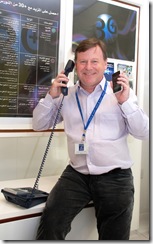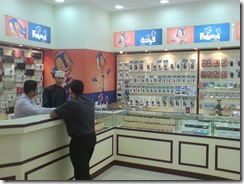Five years after having introduced mobile services in Oman in March 2005 as the country’s second provider, Nawras has grown to become one of the most successful new entrant launches in the Middle East. Counting a subscriber base virtually on par with the incumbent and having innovated in a number of key areas, the introduction of fixed-line services and preparation for an IPO before the end of the year is likely to round off a spectacular fifth year of operation for the company
Ross Cormack has presided over the growth, development and success of Nawras over its five years of existence
At the end of March 2010, Qtel Group reported that its subsidiary Nawras counted 1.94 million subscribers, up 22 per cent year-on-year. The operator’s base represented a market share of around 48.5 per cent, given estimates of a total market size of around four million end-March. It is a huge achievement for a second-placed operator to challenge for market leadership in a period of just five years, and things could have been worse for the incumbent Oman Mobile had it not been for the introduction of mobile resellers last year, which helped reduce the effects of churn.
Nawras had been on course to clearly supersede Oman Mobile as the market leader in terms of subscriber numbers, having reported customer numbers to end-June increased by 30 per cent year-on-year to 1.7 million. Oman Mobile reported that at the end of June, its subscriber based had reached 1.797 million, recording a year-on-year growth rate of just 11.8 per cent. Thus the launch of mobile reseller Friendi Mobile, which began operations in April 2009 and raced to 50,000 subscribers within two months and 150,000 within 11 months , helped boost Oman Mobile’s subscriber numbers given Friendi purchases capacity from Oman Mobile.
“We were extremely pleased that we had managed to win the confidence of so many customers and we didn’t do that lightly; we did it through a lot of dedicated teamwork and a lot of focus on service improvement,” said Ross Cormack, CEO of Nawras. He has been at the helm of the company since its launch. “We follow a process of improvement all the time, and we set out from the beginning to change the mobile communications landscape in Oman so I think we have contributed a huge amount towards doing that,” he added.
Given Oman Mobile’s well-entrenched position as the only telco provider in the market prior to Nawras’ launch, in the initial stages the new entrant’s strategy was unashamedly consumer-focussed as it gained presence and started to have its brand assessed by the general public. It also had a narrow focus on a certain number of business customers from early on, having delivered a number of market firsts in order to address the needs of the business community. For example Nawras was the first operator to introduce 3G in Oman in 2006, and over the past couple of years in particular, its share of the business market has grown significantly, to a point that Cormack describes Nawras as being a “major player in the business and corporate market.
“We have achieved this in a similar manner to the launch of consumer. We went to talk to customers, found out how we could provide them with services that made a difference,” Cormack recalled. “Our My Nawras portal for business, for example, is something that we devised after speaking to corporates and identifying the need. The portal allows company administrators to be able to look into the accounts of any of their internal customers using our service, and be able to slice that data any way they want.”
Cormack said the rise of data usage across both corporate and consumer mobile users continues as the number of smartphones in use increases. Nokia, BlackBerry and Apple are the leading handsets driving the uptake of mobile data services, and while Cormack did not offer the percentage of Nawras revenue that is driven by non-voice services, he described the percentage as being much higher than he ever imagined it would be.
“Mobile data is the fastest growing segment of our mobile activity,” Cormack revealed. “Activities are all growing, if I look at mobile voice, it’s growing, if I look at domestic and international they are both growing. If I look at SMS and MMS, they are both growing. SMS is incredibly popular and still growing.”
This continued growth across activities has resulted in robust financial results at Nawras in recent quarters. In Q110 to end-March, Qtel reported that Nawras revenues improved by 19.1 per cent year-on-year to reach QAR 432.1 million (US$118.68 million). EBITDA increased an impressive 70.5 per cent over the period to QAR 251.2 million.
Nawras now covers nearly 97 per cent of Oman’s population with voice and data provided over its EDGE network and counts well over 40 per cent coverage with its 3G + network, utilising HSPA. Investment in its mobile broadband infrastructure places the mobile operator in a strong position to leverage its understanding and interaction with subscribers in the next stage of its evolution as it develops its fixed line offering.
In November 2008 Nawras was named the recipient of the licence to operate Oman’s second fixed-line network, after the initial award of the concession to a consortium that included Hong Kong’s PCCW was overturned. Nawras wasted little time in preparing the groundwork that would aid its evolution into becoming an integrated fixed, mobile and broadband provider, having announced in March this year that it planned to launch its fixed voice and broadband services during the second half of the year.
The operator has been rolling out its fixed network across the sultanate, with approximately 10 kilometres of fibre optic cable being placed in the ground every day, with a target of 5,000 kilometres in mind. 1,500 kilometres of cable have so far been installed.
“We are building a telco backwards in a sense,” commented Cormack. “We are looking to develop our so-called fixed network with the mobile focus that has brought us a very strong customer focus. That is going to be the thrust of our entry into fixed services. All those things we have learnt about how to serve customers are going to help us deliver even more interesting fixed services,” he added.
Nawras has committed OMR 150 million (US$390 million) in investment in its fixed line services to expand infrastructure across the sultanate and acquire the necessary manpower resources.
Nawras plans to offer services and products that respond to user needs as part of its strategy to attract fixed-line accounts
In the middle of May the operator announced the launch of its fixed services for business customers. It introduced the first non-geographical numbering to enable a business to keep the same fixed Nawras numbers even after relocating, while the use of SIP trunks was another Nawras innovation that gave customers access to significantly more voice channels than was previously offered through legacy systems. In addition, Nawras leased line gave customers the chance to access Nawras’ connectivity without replacing their current equipment.
Spanning most of the country, three fibre-optic cable rings make up the backbone network for the new fixed services. Major corporations will be served with their own fibre connection, offering a secure communication provision with excellent quality.
Nawras’ fixed broadband is available to over 54 per cent of the population, with coverage expected to increase to 81 per cent by the middle of 2011. The operator is building WiMAX base stations in addition to laying 5,000 kilometres of fibre optic cable.
According to figures provided by the Telecommunications Regulatory Authority of Oman, there were 267,317 fixed line subscriptions as of December 2009, representing a penetration rate of 9.3 per cent, while Internet subscribers reached 78,135, a penetration rate of just 2.7 per cent.
“We are connecting internationally, we have built our international voice and data gateway and we have run tests on those, so everything is ready to be able to cut over very shortly on those,” Cormack said. “So we’ll be able to signal and switch our own voice and data internationally, which allows us to take advantage of being part of the Qtel Group.”
Residential fixed broadband services are on track to be launched later in the year and will be offered over a WiMAX network at 2.3GHz. Subscribers to the service will be able to check whether they have coverage in a particular area and if they do, they will then be in a position to pick up a kit that they can plug-and-play themselves.
Away from the operational side of the business, Nawras is also busy preparing the details of its much-anticipated initial public offering (IPO) on the Omani bourse. As part of its licensing conditions, Nawras is required to list 40 per cent of the company on the domestic stock exchange in 2010.
“It is a condition of our Nawras licence that we conduct an IPO in 2010. Our plans remain in line with that. No formal announcements have been made as of yet, though we do remain prepared to complete this IPO in 2010,” Cormack confirmed. 
Nawras is 70 per cent held by the Qtel Group, 14.6 per cent by Danish telco TDC, with the remainder being held by Omani institutions including the Ministry of Defence Pension Fund, Royal Office Pension Fund, Diwan of Royal Court Pension Fund, Internal Security Service Pension Fund and Sultan’s Special Force Pension Fund.
Friendi Mobile is the most successful of Oman’s five licensed mobile resellers, and Cormack questions the long-term viability of all licensees
Given the difficult financial market conditions globally, and the pegging back of listings, Nawras’ IPO is set to generate a significant amount of excitement on the Omani stock exchange and beyond.
Philippe Vogeleer, previously chief strategy officer and general council of Jordan Telecom has moved across to Nawras where he has assumed the role of company secretary and general council. Part of his responsibility at Nawras will be overseeing the IPO process, as well as general strategic guidance given his experience working at the region’s first truly integrated operator, Jordan Telecom.
Beyond the IPO, Nawras remains undaunted with respect to the position it seeks to assume in the Omani market. Much publicity has been brought to the telco sector in Oman given the licensing of five mobile resellers, three of which are licensed to purchase capacity from Nawras.
“The space is a lot more crowded. There are a number of resellers, so from where you stand as a consumer, it’s a noisy market, lots of people shouting their wares,” Cormack conceded. “What we have tried to do through all this is to stay true to our original goals, which were continuing to change the mobile landscape, continuing to deliver caring, excellent, and pleasingly different service. Those values permeate everything we do.”
From Nawras’ point of view the resellers are trading network operators’ airtime and so long as the operators can sell that airtime at a margin that makes sense to them, then Cormack believes it makes sense for the operators to work with resellers.
“Now in terms of how many; the market is yet to see how many it can bear. It’s not the largest market in the world and I wouldn’t be surprised to see some business failure at a certain stage in the future,” Cormack forecast.





0 comments ↓
There are no comments yet...Kick things off by filling out the form below.
Leave a Comment